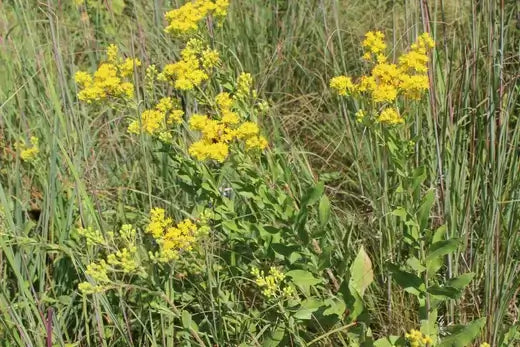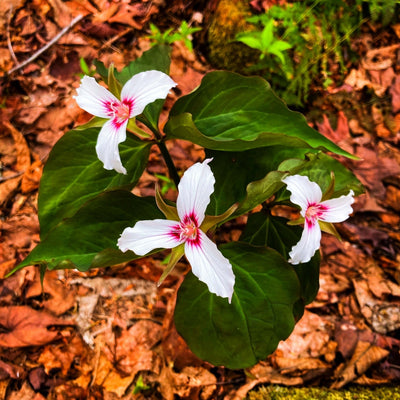Ragweed is one of the most well-known plants that can cause allergies and quickly take over fields and open spaces. Even though it might not seem dangerous, its pollen can make millions of people sick every year. Ragweed is not only bad for people with allergies, but it is also an invasive plant that hurts healthy garden environments by competing with native species.
To keep an allergy-friendly yard alive and well, you need to know how to spot, control, and stop ragweed. Native and compatible plants like the Cardinal Flower, Painted Trillium, and Christmas Fern are sold at TN Nursery to help gardeners keep their ecosystems in balance and stop ragweed from growing.
What is Ragweed and Its Types
In North America, ragweed (Ambrosia), a member of the daisy family, is common. Of the different types of ragweed, the most common are the common ragweed (Ambrosia artemisiifolia) and the giant ragweed (Ambrosia trifida).
- Common Ragweed only gets up to 3 feet tall and has leaves with deep lobes.
- Giant Ragweed, on the other hand, can grow to 6 to 12 feet tall and has bigger, thicker leaves.
A lot of pollen is made by both species, and it can move miles through the air. Because of this, a lot of people have ragweed allergies in late summer and early autumn.
Why Ragweed is Harmful
Ragweed's main problem is its seeds. In one season, one plant can make more than a billion pollen grains. These tiny particles make people with hay fever sneeze, have a runny nose, and have itchy eyes. Ragweed not only causes allergies in people, but it also strongly competes with crops and garden plants for sunlight and nutrients.
Identifying Ragweed in Your Garden
A successful ragweed control strategy begins with accurate identification. These are the most important things to look for:
- Shape of the Leaf: Ragweed leaves are deeply split and look like fern leaves.
- Stems: Hairy, green or slightly brown most of the time.
- Flowers: Are small and yellow-green. They grow in groups at the plant's crown.
- Growth: As it grows, it likes broken soil, roadside ditches, and open areas.
Early summer is when ragweed plants typically grow, and by August, they are producing pollen. Checking the garden often helps catch them before they start to grow.
Effective Methods for Ragweed Control
Ragweed needs to be removed from your garden over time and with a mix of natural, physical and preventative methods. Here are some good ways to handle it:
1. Removal by hand
The ideal time to get rid of ragweed is before it blooms. Pull the plants out by hand when the ground is still wet. Make sure to get rid of the full root so it doesn't grow back.
2. Covering the ground and mulching
Putting down a thick layer of mulch or growing plants that cover the ground in a packed way can help keep ragweed seeds from sprouting. Plants like the Christmas Fern naturally cover an area, adding colour and keeping weeds away.
3. Suppression by nature
Put in native plants that can resist ragweed well. Species like the Painted Trillium and Cardinal Flower grow well in the same conditions, but they don't spread; they just add variety.
4. Proper Lawn and Soil Management
Rakeweed can't grow where the dirt is healthy and the grass is thick. Fertilising and keeping the soil wet stops seeds from spreading and helps plants grow.
Tips for Preventing Ragweed Growth
It is much easier to stop ragweed from growing than to get rid of a big crop. For easy ragweed allergy tips and yard safety:
- Mow often to stop plants from growing and spreading seeds.
- Check the edges of your garden and the fences to see if ragweed is growing there.
- To ease allergy symptoms wear masks and gloves when handling ragweed.
These ragweed allergy tips will not only keep you safe from pollen, but they will also help keep your garden cleaner and healthy.
How to Kill Ragweed Naturally
Natural methods are best for farmers who want to get rid of weeds in an eco friendly way. These safe options can be used instead of chemicals:
- Treatment with Boiling Water - Young ragweed plants die quickly when you pour boiling water on them
- Vinegar Spray - To treat trouble spots, mix vinegar and water together and spray it on
- Soil Solarization - Cover areas that are infested with weeds with clear plastic for a few weeks in the summer to kill the seeds through heat
While protecting the health of your soil, these non-toxic methods offer effective ragweed control.
Why Ragweed Matters for Allergy Sufferers
One of the main contributors to seasonal allergies is ragweed pollen. Airborne pollen can travel a long way, even if there isn't any ragweed close. Gardeners with allergy complaints should be extra careful from August to October, when pollen counts are highest.
By planting ferns, trilliums, and native flowers from TN Nursery and other allergy-friendly plants, you can help keep the balance and stop the spread of plants that cause ragweed allergies.
FAQs
What is ragweed and why is it harmful?
Ragweed is an invasive plant that makes a lot of pollen, which can make people with allergies sick and make it hard for other plants to grow in the yard.
How can I remove ragweed from my garden?
Before it flowers, pull it out by the roots and cover the ground with mulch or a thick plant like Christmas Fern to stop it from growing back.
Which types of ragweed are most common?
The most common types of ragweed in gardens and open areas are common and giant ragweed.
How can I prevent ragweed growth naturally?
Keep the soil healthy, fill in any empty spots, and plant natural plants that will compete with the weeds, like Painted Trillium and Cardinal Flower.
Are there plants that help reduce ragweed in gardens?
Yes. Plants that grow back every year, like Christmas Fern or Wildflowers from TN Nursery, can easily push ragweed out of the way.





